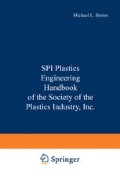Overview
Vinyl dispersions are fluid suspensions of fine-particle-size polyvinyl chloride resins in liquid plasticizer/diluent systems. The viscosity of the plastisol may range from a pourable liquid to a paste, depending on the formulation. When heated to about 150 to 170°C (302–338°F), the dispersion turns into a homogeneous hot melt. When the hot melt is cooled to around room temperature (25°C, 77°F), it becomes a tough vinyl product.
Most vinyl applications that use dry blend or pelletized vinyl compounds require heavy melt processing equipment such as calenders, extruders, injection molders, blow molders, and so on. With vinyl dispersions the processor can use convenient liquid handling techniques such as casting, spraying, strand coating, rotomolding, dipping, and so forth.
The term “plastisol” is used to describe a vinyl dispersion that contains little or no volatile thinners or diluents (Fig. 16–1). Plastisols range in viscosity from water-thin liquid to a heavy paste with a consistency of mayonnaise. The ingredients generally include PVC resins, plasticizers, stabilizers, fillers, and pigments. When no volatile thinners are included, the plastisol is considered as high solids (98–99%). There is always some evaporation of plasticizers during the curing cycle.
It is convenient in some instances to extend the liquid phase of a dispersion with volatile dispersants or thinners, which are removed during fusion. The term “organosol” applies to these dispersions (Fig. 16–1).
Approximately 10% of the polyvinyl chloride resin used in the United States is dispersion-grade resin. The major markets for PVC dispersion resins are floor coverings, carpet tiles, coated industrial fabrics, medical gloves, decorative films, coil coating, and automotive sealants.
Access this chapter
Tax calculation will be finalised at checkout
Purchases are for personal use only
Preview
Unable to display preview. Download preview PDF.
References
W. L. Semon, U.S. Patent 1,929,453 (Oct. 10, 1963), assigned to The BFGoodrich Company.
G. W. Johnson, British Patent 500,298 (Feb. 7, 1939), I. G. Farbenindustrie.
W. L. Semon, U.S. Patent 2,188,396 (Jan. 30, 1940), assigned to BFGoodrich Company.
“More Solutions to Sticky Problems,” Brookfield Engineering Laboratories, Inc., Stoushton, MA.
A. C. Werner, “Spread Coating,” Encyclopedia of PFC, Marcel Dekker, Inc., New York, 3(26), 1415–1475 (1977).
Technical Bulletin, “Rotovisco RV-20,” Hanke Buchler Instruments, Inc. Saddle Brook, NJ.
Technical Bulletin, “Carri-Med, CS Rheometer,” Mitech Corp., Twinsburg, OH.
L. E. Nielsen, Mechanical Properties of Polymers, pp. 30–35, Van Nostrand Reinhold Co., New York, 1962.
J. A. Sarvetnick, Plastisol and Organosols, Van Nostrand Reinhold Co., New York, 1972.
Modern Plastics Encyclopedia, 1972–1973.
Plastics World, Directory of the Plastics Industry, Vol. 30, No. 11 (Aug. 1972).
E. A. Collins, D. J. Hoffman, and P. L. Soni, “Rheology of PVC Plastisols,” Rubber Chemical Technology, 52(3), 676 (1979).
D. W. Ward, “Reactive Functionality in Dispersion Resins,” SPE Journal, 28, 44–50 (May 1972).
Modern Plastics Encyclopedia, 1988–1989.
J. K. Sears and J. R. Darby, The Technology of Plas-ticizers, John Wiley and Sons, New York, 1982.
P. D. Ritchie, Plasticizers, Stabilizers, and Fillers, The Plastics Institute, Iliffe Books, Ltd., London, 1972.
L. P. Whittington, A Guide to the Literature and Patents Concerning Polyvinyl Chloride Technology, Society of Plastics Engineers, Stamford, CT, 1963.
W. D. Todd, D. Esarove, and W. Smith, Modern Plastics, 34(1), 159 (1956).
T. C. Jennings and Charles W. Fletcher, “Actions and Characteristics of Stabilizers,” Encyclopedia of PVC, 2nd ed., Marcel Dekker, Inc., New York, 1988.
W. V. Titow, “Colourants,” PVC Technology, Fourth Edition, Chapter 11, pp. 401–419, Elsevier Applied Science Publishers, London and New York, 1984.
T. B. Reeve, “Pigment Colors for Vinyl Coatings,” Pigments Department, E. I. du Pont de Nemours & Co., Wilmington, DE.
Technical Bulletin, “Ircogel,” Lubrizol Diversified Products Group, Wickliffe, OH.
BFGoodrich Technical Bulletin No. HM-15, “Modifying Plastics with Hycar and Hydrin Elastomers,” Cleveland, OH.
D. G. Higgins, “Coating Methods Survey,” Encyclopedia of Polymer Science, Vol. 3, p. 766, John Wiley and Sons, New York, 1965.
R. J. Jacobs, “Fundamentals to Consider in Selecting Coating Methods,” reprint from Paper Film and Foil Converter.
George L. Booth, “Take Your Choice of Coating Methods,” Modern Plastics Magazine (Sept. and Oct. 1958).
George L. Booth, Coating Equipment and Processes, Lockwood Publishing Co., New York, 1970.
R. P. Conger, SPE Journal, 24(3), 43 (Mar. 1968).
Eastman Chemicals Publications L163, L164, and L165 on “Adhesion Promoting Plasticizers,” Eastman Chemical Products Co., Kingsport, TN.
See, for example, G. H. Poll, “Painting Aluminum at 200 fpm,” Products Finishing, pp. 2–9 (July 1969).
P. F. Bruins, Basic Principles of Rotational Molding, p. 276, Gordon and Breach, Science Publishers, New York, 1971.
Ibid., p. 278.
Author information
Authors and Affiliations
Editor information
Rights and permissions
Copyright information
© 1991 Van Nostrand Reinhold
About this chapter
Cite this chapter
Edwards, W.A., Shah, A.C., Mikofalvy, B. (1991). Vinyl Dispersions. In: Berins, M.L. (eds) SPI Plastics Engineering Handbook of the Society of the Plastics Industry, Inc.. Springer, Boston, MA. https://doi.org/10.1007/978-1-4615-7604-4_16
Download citation
DOI: https://doi.org/10.1007/978-1-4615-7604-4_16
Publisher Name: Springer, Boston, MA
Print ISBN: 978-1-4615-7606-8
Online ISBN: 978-1-4615-7604-4
eBook Packages: Springer Book Archive

